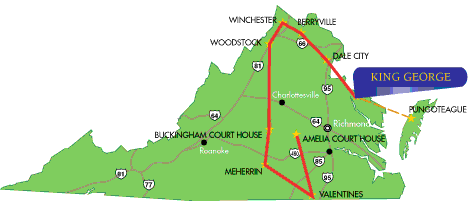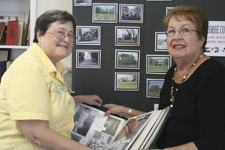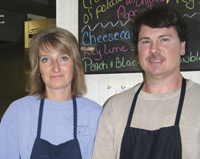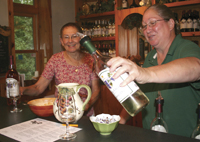Download in PDF Format
Former teacher Dave Arnold, owner of Green Acres, a
nursery/landscaping/ grounds-maintenance company, has lived in King George
since 1998.
The Pennsylvania native is succinct when asked about life
there: “I like the rural area. I’m a boater and do a lot of water
activities, and it’s close to the river. It’s rural and laid-back but there
are still things to do here.”
Anchored by King George Courthouse, built in 1915, and a
modern two-story county administration building, King George includes a
smattering of shops, businesses, restaurants and churches. Sixty-four miles
north of Richmond and 58 miles south of Washington, D.C., it’s the county
seat for King George County, dubbed “The Gateway to the Northern Neck."

The county seat is anchored by King George
Courthouse in a modern county administration
building. |
Captain John Smith explored the area in 1608, then home
to Native Americans of the Powhatan nation. Carved from Richmond County in
1720 and named for Great Britain’s King George I, the county is traversed by
two major thoroughfares — U.S. Route 301 and U.S. Route 3 — and boasts 131
miles of shoreline on the Potomac and Rappahannock rivers, along with lush
farmland and a wealth of history.
In 1918, the U.S. Navy established the Naval Proving
Grounds at Dahlgren in King George County to test naval guns. Today,
Dahlgren’s Naval Surface Warfare Center (NSWC) is the county’s major
employer, focusing on research, development, military safety testing,
integrated warfare systems, weapons and ammunition, sensors and
homeland/force (military personnel and equipment) protection.
The economic impact of NSWC is undeniable. According to
county administrator Travis Quesenberry, in 2008 Dahlgren had 4,184 civilian
employees and 370 military employees and/or soldiers, in addition to over
4,200 “badged contractors” who provide goods and services to Dahlgren.
Quesenberry, who oversees day-to-day county operations, grew up in “the
farming part” of the county and says NSWC has been “a good partner with us.”
A new CVS store is coming, new restaurants have opened
and Wal-mart is opening a Dahlgren store. Two other large employers, the
county landfill and a GE power plant, are in the county. Quesenberry says
the landfill brings the county $6 million dollars annually, all of which
goes to capital improvements.

Travis Quesenberry is
the county administrator. |
“There’s a 30-year agreement with the landfill, with 17
years remaining until the landfill is filled, so we’re trying to expand our
economic base in anticipation of that,” he explains. “King George Industrial
Park opened in 2003 and we have a precast-concrete company, a
steel-fabricating company and asphalt plant there, but there’s 50 or 60
acres not built on so there’s room for expansion.
“We want to maintain our rural county, but we also need
to expand our economic base,” Quesenberry adds. “A year ago we hired an
economic development director and we’re working with Northern Neck tourism
to expand our tourism efforts. We’re a bedroom community to some extent,
with a lot of subdivision activity near Dahlgren.”
Quesenberry says the county’s biggest challenge is facing
reductions in funding from state budget cuts, noting, “We haven’t been
impacted as badly as some areas with property tax and business tax issues
... we’ve weathered the economic downturn well.”
The Big Events
Two large community events are held annually. The King
George Fall Festival, which began in 1959, is held the second weekend in
October each year and includes a parade through town, a carnival and crafts.
Proceeds from the event help support King George Fire & Rescue. The King
George Home & Craft Show, organized by the King George Builders Association
and the local Journal weekly newspaper, is held the first weekend in March
and features all sorts of home-related exhibits, crafters’ displays, vendors
and community organizations.
Elizabeth Lee, a retired NSWC physicist who grew up in
King George, says the hardest thing for people to understand is “we have no
towns or cities, we are a rural community.
“King George proper we call the village sometimes, but
you blink and it’s gone,” Lee says. “There are no incorporated towns in the
county.”
Lee recalls as a child not being able to travel at times
on Route 301 due to heavy traffic: “We had a farm on 301 highway, and my
parents also had a farm where I live now. There was a back road so they
could get over there from one farm to another to feed the animals, because
they couldn’t get out on the highway. Then I-95 came along and 301 traffic
disappeared.”
Although the area has grown, she adds, “There is
community involvement here, and if something happens, people will feed you
and make sure you have all you need.”

Elizabeth Lee and Jean
Graham are museum volunteers.
|
Lee co-authored A Pictorial History of King George County
in 2006 with friend and fellow King George County Historical Society
volunteer Jean Graham. Graham, a genealogy buff who says she’s “been back
home” for 22 years, says of life in King George, “I love every second of it!
I live on the water on the Potomac and I don’t have enough hours in the day.
I’m not a person who’s ever been bored.”
Both women volunteer at the King George County Museum and
Research Center, housed in the old jail at the east end of the courthouse
building. Open Thursdays and Saturdays March through October, and Saturdays
November through February, the free-admission museum displays everything
from prehistoric oyster shells to Native American and 1700s-era artifacts. A
research collection includes books focusing on area history, published
genealogical information and files on family histories, places and events
available for researchers.
A society task force was formed to research the area
where 80 people died after the steamboat Wawaset burned and sank in 1873
(see “At a Glance”) off King George shores, resulting in the boat’s wreckage
being located with the help of U.S. Navy divers. In August, the group
organized a memorial/county volunteer picnic attended by 300 people to
commemorate the tragedy, including erection of a granite marker on the beach
in memory of those who died.
Author Alvin Oickle, who wrote Disaster on the Potomac —
The Last Run of the Steamboat Wawaset, signed copies of his book at the
event. The book is available at the county museum.
“I love history, so my thoughts are on the preservation
of sites that have meaning for the county,” Lee says.
Community Fixtures

Natives Howard and
Virginia Burchell are the proprietors of
Howard's Bakery and Restaurant.
|
Down the road from the courthouse at 9237 Kings Highway,
Howard’s Restaurant & Bakery, a local hangout featuring down-home cooking
and menu items like fried flounder and grilled chicken, is buzzing at
lunchtime. Among the diners is Phyllis Jett, a certified nursing assistant
from nearby Colonial Beach.
“It’s comfortable in Colonial Beach ... I knew everyone,
but now I go there and don’t know a soul,” Jett explains. “King George is a
nice place, and the people still pretty much know each other here.”
Howard’s owners Howard and Virginia Burchell grew up in
King George. Howard explains, “Life here is calm, peaceful and safe. Even
though as business owners we want to see growth, we want to keep the rural
feel. You go to a lot of communities, they don’t welcome new people well ...
We still have a personal touch here in King George.”
Another community fixture is Mary’s Cakery & Candy
Kitchen, owned by Mary and James Deatherage, located just off the main drag
of Kings Highway at 10305 Indiantown Road. Mary’s 2,300-square-foot
store/kitchen is the largest privately owned specialty chocolate store in
Virginia, filled with gifts, handmade chocolates, homemade fudge and fresh
cakes, pies and cookies. Unique items abound, such as caramel apples,
pumpkin pie fudge and apple pie fudge in the fall months.

Amanda Christensen and
Amanda Bratz enjoy their work at the counter
of Mary's Cakery & Candy Kitchen.
|
One of 15 employees, college student Amanda Bratz likes
the quietness of King George, noting she can drive 20 minutes to the movies
or mall in Fredericksburg or have fun with friends at local cookouts.
Self-described “Mary’s assistant” Christy Davis moved to the area five years
ago with her husband and also likes the area, explaining, “I grew up in a
town of 1,300 people so I am used to small towns ... people are so nice
here. We have local support, but we also have people who drive two hours for
Mary’s cakes or special orders.”
Down-to-Earth Winery
A short drive from the courthouse area is Oak Crest
Vineyard & Winery, a lush oasis owned by Conrad and Dorothy Brandt. Dorothy
jokes that the family-run business is “a hobby that went astray,” adding,
“My husband’s German grandfather made wine and Conrad started studying
winemaking and made wine for home use. We started planting our first grapes
in 1986. I heard grape growing, not winery, but I got an inkling of the
business when he started doing drawings for this facility. We broke ground
in 1999 and opened in 2002.”
The Brandt-designed winery is built into a hillside two
stories into the ground, providing natural cooling for an underground
cellar. Along with complimentary wine tastings, the shop offers not only
wine for sale but handmade pottery, bird sculptures by a local artist, and
gifts. There are outdoor picnic areas and a landscaped patio area hosts
weddings, receptions and private parties. An eight-acre adjacent field is
laden with symphony grapes for white wines and red bordeaux grapes for red
wines.

Dorothy Brandt and her
husband Conrad own and operate Oak Crest
Vineyard & Winery.
|
Dorothy says, “We want customers’ experience to be
pleasant and enjoyable, not stuffy. We have soft drinks available, and kids
get juice and crackers when they come.”
The Brandts, who moved to King George in 1961, like life
in the slow-paced community.
“It’s very rural here but this is commercialized compared
to when we first moved here and had to go to Fredericksburg just to buy
groceries,” Dorothy explains.
Elizabeth Lee confirms the area has seen much growth over
the past 20 years.
“Being an oldie, I’d like to see King George not
developed so fast,” she says. “I’d like it to stay partly rural. I am hoping
others see it that way.”
|